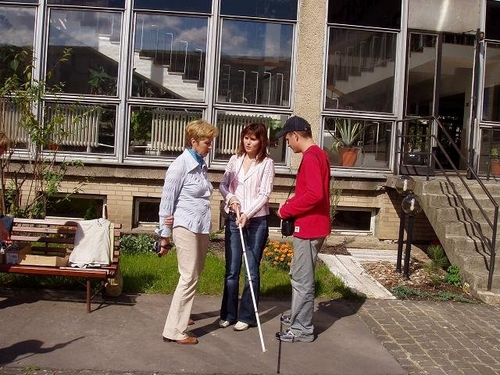English
The idea of the establishment for the Institute of the Blind came from the Ministry of Social Affairs. It was donated by the Ministry of Education and Enlightment on 25th January 1922. The institute was open on 1st May 1922. Nine of eleven inmates aged 8 till 15 were registered. Till the end of that year other 15 pupils came.
There were already 36 pupils at school in the school year 1923/24. Adolf Fryc was the first appointed headmaster, who till that time had worked in Deyl Institute for Blind in Prague.
Among the teachers, who strongly influenced the progress of the school, we have to mention one of them, Viliam Hrabovec, the author or the embossed maps, globe and other specific equipments for the blind.
Jozef Szász, the director of the State Institute for the deaf-mute, was in charge since 1938. The school flourished, achieved good results, although suffered difficult times, e.g. the final year of the second world’s war. The hospital for soldiers was open at the school ground, the teachers enlisted, the students were moved out, most of them went back home. After Levoča was liberated again, the school building got its original image back for a short time. The lessons started in 1945/46. The director Ján Šoltés who became a professional, went on using the important traditions in Slovak tyflopeadia. He proposed to start other two school departments for the blind pupils, other specialized classrooms, the magazines for the blind were published. The teacher Jozef Vrabel succeeded in opening the first printing office for the visually handicapped in Slovakia, which was originally situated at school, but later moved into its own location.
In 1958 the nursery school for the visually handicapped was open and more classrooms for the visually handicapped with the mental disability were added. Among other school directors belonged Juraj Mráz, Jozef Milčák and Ladislav Gajdoš.
The school modernization became in the 1980s with the strong support from Sweden and Germany. The new teaching tools came into school in 1989 from other countries. Since 1991 the Special Pedagogy Advisory Centre has been working within the school. Thanks to Hilton Perkins Foundation there were set the conditions for the education of visually handicapped children with the serious corporal defect. Since 2003 the school has been barrier-free.

The residence of students at school is complementing of many activities.
MUSIC
The Blind children love music. The school for Blind in Levoca pay big attention to music art, because Blind people have got more developed sensible sense.
VISUAL ARTS
The pupils of our school evolve in visual arts once a week. For get better touch they practise exercise in macro and micro area, improved in their manual and graphic-motion skills, they learn to model, to draw and to decorate.
POTTERY WORK
The work is dependent on pupil’s physical force (muscular power, endurance and activity). Thanks to sponsors has opened ceramic studio, for first contact of kids with manual modelling material.
PREPARE FOR FAMILY LIFE
The uniform admission is the main principle in prepare of Blind for daily life, same as for their next education and work.

PaedDr. Šarlota Múdra, head teacher
Dušan Netík, the assisstant of Primary school for visually impaired children
Mgr. Viera Kamenická, the assisstant of Special primary school and kindrgarden for visually impaired children
Mgr. Tatiana Huszthyová, the head warden of the school hostel

Except the gym there is also a fitness centre. They can try their courage on an artificial climbing wall.
Our school has several computer laboratories with the connection on the internet.
Those children with prolems such as dyslexia, dysgraphy ... are provided a free therapy EEG Biofeedback.
Our school has also a library, where the employees and the children can find many suitable books.
There is also a nurse who looks after the health of our pupils. School psychologist takes care of mental health of the children and social worker provides consulting for parents.

The school provides the education of children aged 6–16 and is equal with the curriculum in usual primary schools. All the teachers and wardens have education in special pedagogy.
Our teachers are the authors of many textbooks, methodics, teaching aids and other professional works connected with visually impaired children.
Our students have the access to different teaching aids. The classrooms are equipped with special furniture. The windows in the classrooms with too much light have blinds, and any student with residued vision can use a magnifying glass, local illumination of his workplace, special exercise books and so on.
There is maximum 10 students in one class. There are 8 students in a class on the first stage and 6 children in special classes.
Education of multihandicapped children is provided in the special school classrooms according to variants A, B, C.
Most of our children dwell in the hostel which provides several services such as accommodation, food, laundry and ironing during the entire school year.

